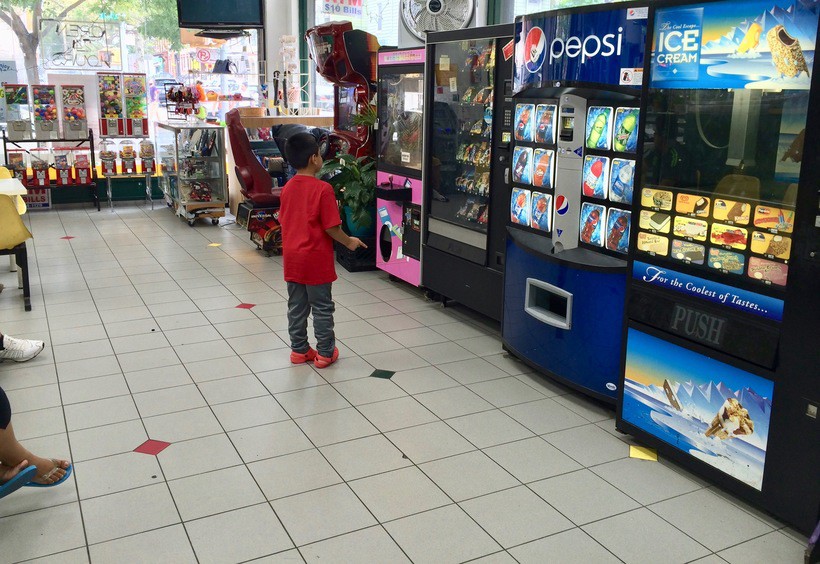If you happen to enter a department store this holiday season, you might expect displays of home goods and electronics, women’s and men’s clothing, jewelry, baggage, cosmetics, and accessories. What you might not expect are aisles of candy, cookies, chips, and soda. After all “food” is not generally one of the departments in a department store. A department store is not a “food store.” Or is it?
Surprising food sources
It turns out, department stores do often sell food — and drinks. The drinks they sell are almost always sweetened, and the “food” (edible substance if not nourishing sustenance) is usually highly processed pre-packed product.
Such food and drink might be expected from categorical “food stores” (e.g., supermarkets, grocery stores, corner stores, and bodegas). Likewise restaurants, bars, and cafes are obvious retailers in the food-and-drink space. Department stores might be less-intuitive “food stores,” although they are far from alone among other business that surprisingly sell foods and beverages.
My own research finds foods and beverages being sold from a wide variety of businesses: from pharmacies, gas stations, and newsstands, to barber shops and beauty salons, auto shops and car washes, sporting goods stores and apparel shops, banks and check cashing outlets, hardware stores, laundromats, dollar stores, office depots … even medical offices. The proportion of such businesses selling food or drink varies considerably by neighborhood, as do the specific types of products that are on offer.
Neighborhood disparities
For instance, take the Bronx, where most of my patients live. The Bronx is home to mostly lower-income minority communities afflicted by staggering rates of obesity and diet-related diseases. Diabetes in particular is prevalent, and a high portion of the population frequently consumes sugary beverages. How unfortunate then that nearly 40% of all Bronx businesses offer some kind of food or beverage with nearly half of these businesses offering less-healthful items exclusively (items like sodas, candies, cookies, cakes, and frozen confections).
In contrast, consider Manhattan’s Upper East Side, an upper-income white community with relatively low levels of obesity, diabetes, and sugary-drink consumption. The number of businesses offering foods and beverages among the white and wealthy of Manhattan is only a little more than one in four, and only a small minority (
Food desert myth
In both areas — the Bronx and Manhattan — there is a lot of surprising food in a lot of surprising places, but in the Bronx particularly, the situation can look a lot like desserts in a desert — or desserts in a “food desert” (at least as conventionally conceived). Food deserts are areas lacking in access to healthful whole foods — a determination often based merely on supermarket absence (no supermarkets = food desert).
Certainly supermarkets carry wholesome foods and supermarkets are not very common in the Bronx. But that doesn’t mean that healthful foods are nowhere to be found.
Just as non-supermarket retailers often sell sweets and treats, many also offer some healthier options (e.g., nuts, seeds, whole-grain products like granolas, and fruit). The provision of healthier options occurs more often in Manhattan, but such provision offers real potential to improve diets and health — in both boroughs and more generally (as generally in the U.S. there is too much dessert in too many places).
Unhealthful environment
The problem of near omnipresent dessert is not just limited to local retailers. There are too many sweets at home (e.g., for holiday after holiday presently), too many sweets through school (examples too numerous to list here), too many sweets at work (e.g., in the break room, kitchen, and at various events). Really, there is too much processed junk food overall, which compromises our health and tends to make double victims of those of us sick and suffering and struggling to control weight.
Obesity is a pandemic problem, as are the diet-related diseases that tend to come with it. While rates of newly occurring diabetes in this country have finally begun to fall (after at least 2 decades of stubborn increase), and while there have been recent improvements overall in the diet quality of Americans, these changes have not been realized equally across the population. In fact, income and racial disparities have only widened. For many people, like many of my patients in the Bronx, things have only gotten worse. Desserts in the desert are not helping.
Dumps to gardens
Then again, maybe we’re not actually talking “deserts” here. Supermarkets or not, food is everywhere. There are rarely barren expanses devoid of edible offerings. The problem is not the absence of something to eat, the problem is that what is available to eat — particularly for those most-vulnerable and most-struggling — is garbage. It is less the case that we have “deserts;” it is more the case that we have “dumps!”
Trying to keep sweets and treats out of various retail businesses might be one solution. Alternatively, maybe we could cultivate options to make our “dumps” more resemble gardens. Fruits, vegetables, nuts, seeds, and whole grains could do a lot to offset the influence of ubiquitous desserts. Shelf-stable items like dried fruits, jarred salsas, bagged nuts, and trial mixes offer real potential, as do portable fresh fruits.
If we must have food at our auto parts stores and office supply depots, perhaps we can get more healthful options into the mix. Promoting more whole foods could make so-called “deserts” less dumpy, and more vegetal and healthful.
Dr. Lucan is supported by the Eunice Kennedy Shriver National Institute of Child Health and Human Development of the National Institutes of Health under award K23HD079606. The content of this manuscript is solely the responsibility of Dr. Lucan and does not necessarily represent the official views of the National Institutes of Health.


Originally published at www.huffingtonpost.com on December 20, 2016.


